What Happens After September 30?
By Colin Twiggs
September 22, 2007 4:30 a.m. ET (6:30 p.m. AET)
These extracts from my trading diary are for educational purposes and should not be interpreted as investment advice. Full terms and conditions can be found at Terms of Use.
USA
The market has taken the Fed rate cut as acknowledgement of the seriousness of the subprime mortgage crisis. The Dollar Index fell to a new 10-year low, while gold broke through resistance at $730 to establish a new 10-year high. Retracement or consolidation that respects the new ($730) support level would provide confirmation of the breakout — offering a long-term target of $900 [730+(730-565)].
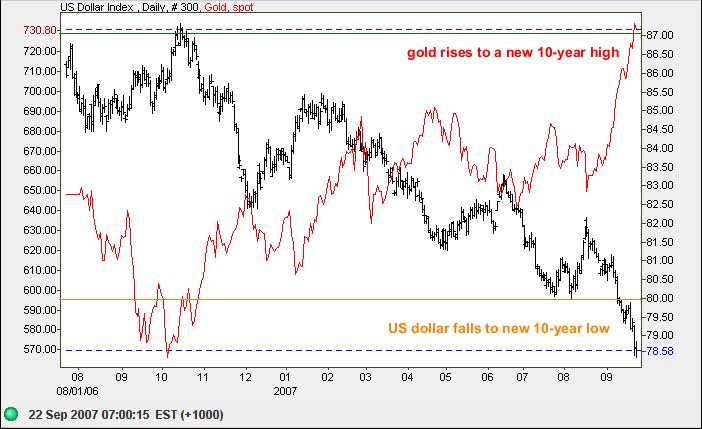
The falling dollar is likely to stimulate exports, but the current credit squeeze will endure for some time. Fed Chairman Ben Bernanke, testifying at Thursday's House Financial Services Committee hearing, hinted that he expects the crisis to be over by March (Times Online). Testifying at the same hearing, Alphonso Jackson, secretary of housing and urban development, estimated that about 500,000 subprime home loans would enter foreclosure — of the 2 million scheduled to be reset by the end of 2008. Fifteen percent of subprime loans were 90 or more days delinquent in July, triple the level of two years ago.
Declining residential investment is a reliable leading indicator, predicting 8 of the last 10 recessions, according to Professor Edward Leamer of UCLA. Only two false signals have been given since WWII, in 1951 and 1966, and 1966 was initially recorded as a recession by the NBER before later being revised. Seasonally adjusted housing starts (August 2007) have fallen 42% from their peak in January 2006 according to the NAHB, while starts for one unit dwellings are at their lowest level since the recession of 1990-1991.
The market is far from reassured, driving Treasury bill yields to below 3.75%, the lowest level since the first week of the crisis.
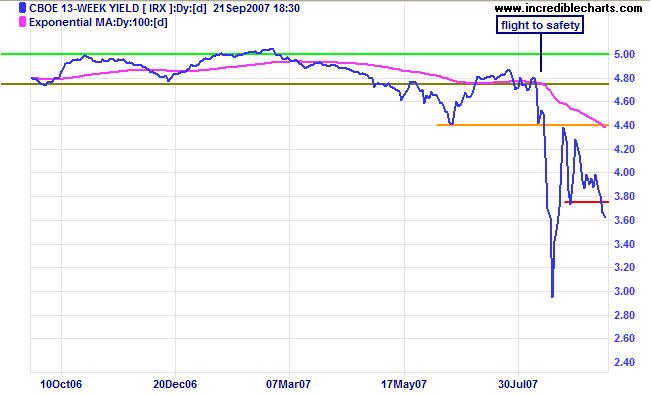
Dow Jones Industrial Average
Despite the gloomy forecasts Dow Jones Industrial Average is headed for a test of its all-time high of 14000, and possibly the upper trend channel. The index is supposed to embody all available knowledge of the market, whether published or private — so who do we believe? The primary trend is invulnerable to manipulation, but shorter cycles are not. Considering that we are approaching the September 30 quarter-end valuation for many fund managers, expect equity markets to hold on to current gains until then. After that, all bets are off.
Twiggs Money Flow signals medium-term accumulation, and a rise above the July high would indicate buying strength. The primary trend is up, but respect of resistance (at 14000) would warn of a test of primary support at 12800.
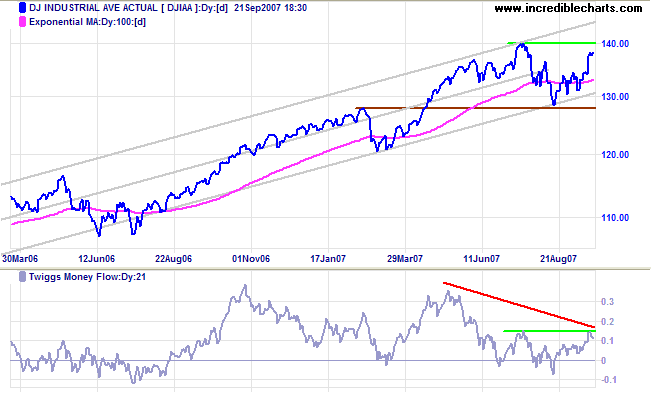
Short Term: Volatility is falling while the index consolidates after breaking through 13700 on modest volume. Friday's large volume is attributable to triple-witching hour. A rise above 14000 would signal another primary advance, with a target of 15200, but beware of false/failed breakouts. Reversal below 13700 would signal weakness.
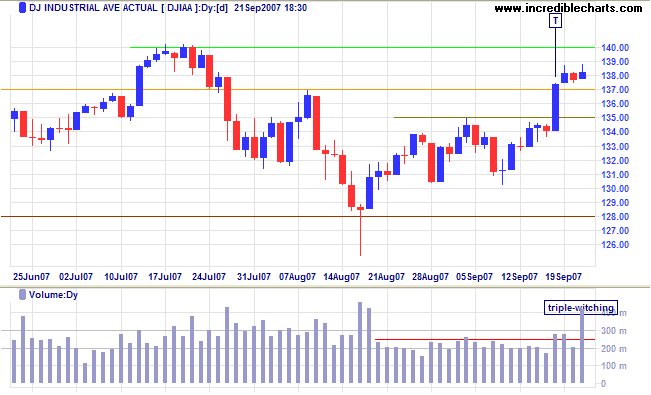
Transport
Dow Jones Transportation Average continues to test support at 4700 and a downward breakout would signal the start of a primary down-trend. Fedex is testing medium-term support at $104, reflecting uncertainty over the economy.
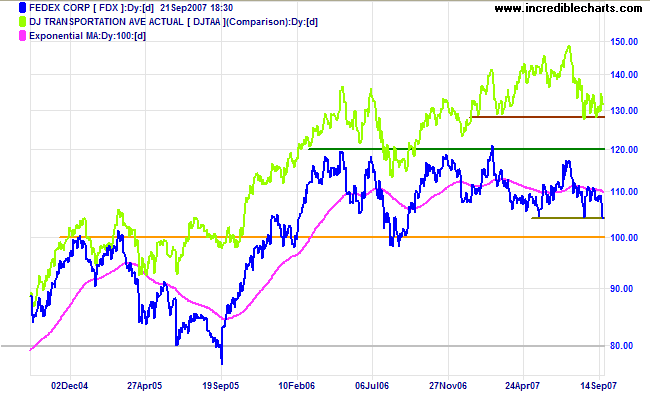
Small Caps
The Russell 2000 is declining relative to the large cap Russell 1000 index. The Price Ratio decline below the August low confirms a long-term migration to the safety of large cap stocks.
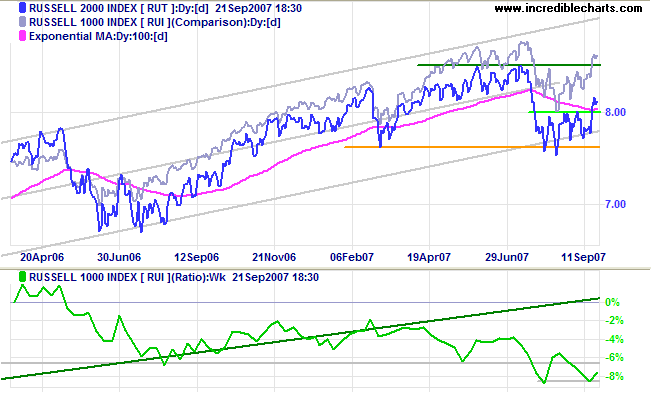
S&P 500
The S&P 500 is consolidating after breaking through 1500. Twiggs Money Flow signals medium-term accumulation and a rise above the July high would add further strength. The primary trend is up and a test of 1555 likely; breakout would signal another primary advance. Reversal below 1500, however, would signal weakness and a test of primary support at 1400.
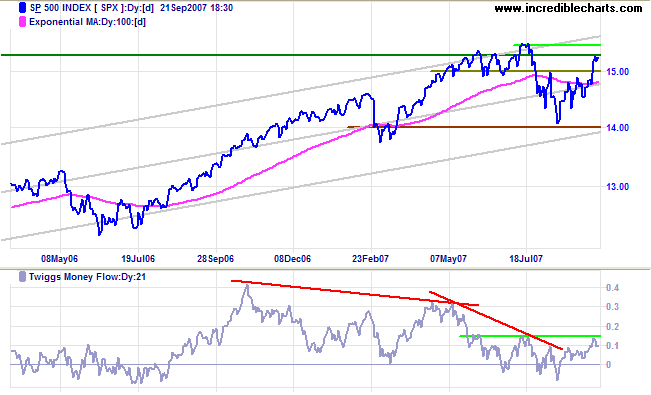
United Kingdom: FTSE
The FTSE 100 broke through resistance at 6400, signaling continuation of the primary up-trend, and is now consolidating. Rising Twiggs Money Flow signals short-term accumulation and breakout above the July high would strengthen the signal. A test of 6750 is expected, but reversal below 6400 would indicate weakness and another test of primary support at 6000/5850.
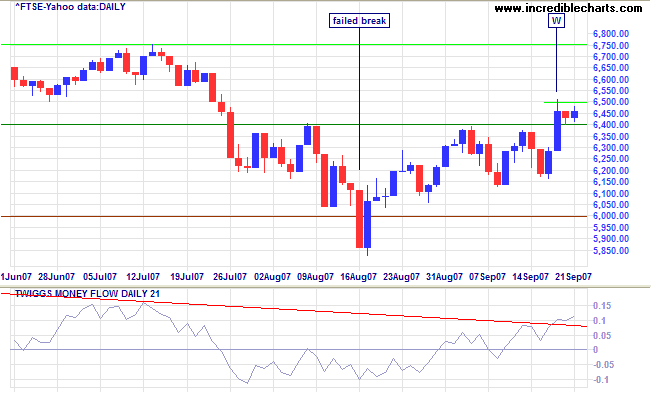
India: Sensex
The Sensex broke through resistance at 15700, signaling a primary advance with a target of 17400 [15700+(15700-14000)]. Rising Twiggs Money Flow signals medium-term accumulation. Reversal below 15700, while not expected, would warn of another test of primary support at 14000.
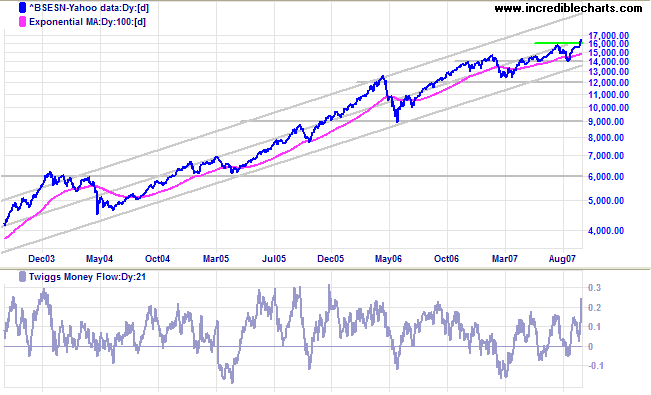
Japan: Nikkei
The Nikkei 225 continues to test resistance at the former primary support level of 16600, indicating possible weakness, while Twiggs Money Flow whipsaws around zero, signaling uncertainty. Breakout above 16600 would signal a test of primary resistance at 18300, but not necessarily a change from the primary down-trend. Breakout below 15600, on the other hand, would warn of another primary down-swing.
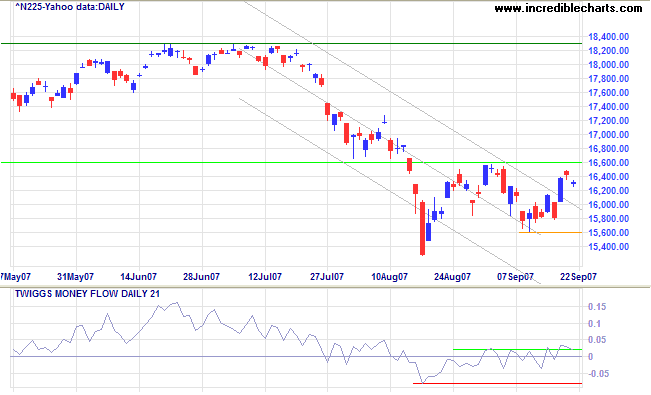
China: Hang Seng & Shanghai
The Hang Seng is advancing in a strong primary up-trend towards the upper trend channel and its target of 26700 [23500+(23500-20300)]. Breakout above the recent consolidation signals a rally to test the upper border of the trend channel. Rising Twiggs Money Flow reflects strong medium- and long-term accumulation.
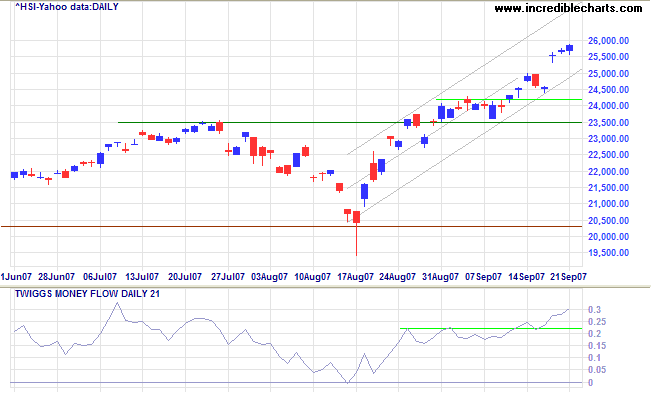
The Shanghai Composite is following the lower border of its trend channel, while a mild bearish divergence on Twiggs Money Flow, since mid-August, indicates medium-term distribution. Narrow consolidation above 5400 indicates that a rally to test the upper trend channel is likely, with long tails on the red candles indicating buying support. Reversal below 5400, however, would signal another test of support at 5000, and breakout (below 5000) would warn of a secondary correction. The primary up-trend is in the final stage of a bull market — where speculation dominates and advances are based on expectations of further price rises rather than actual results.
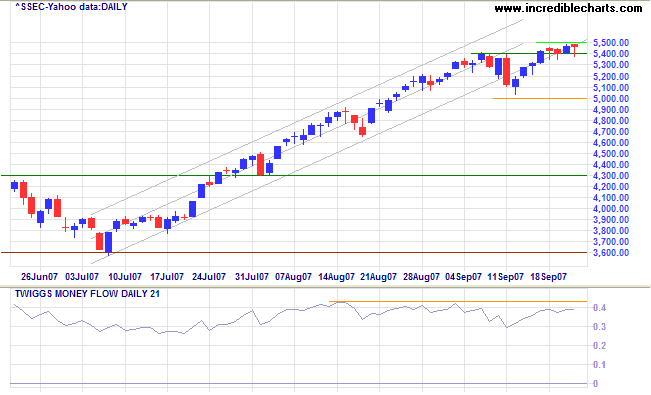
Australia: ASX
The All Ordinaries is advancing towards a test of the previous high at 6460, now in step with the Dow and S&P 500. Twiggs Money Flow, however, displays a short-term bearish divergence, signaling resistance. A rise above 0.2, however, would be a bull signal.
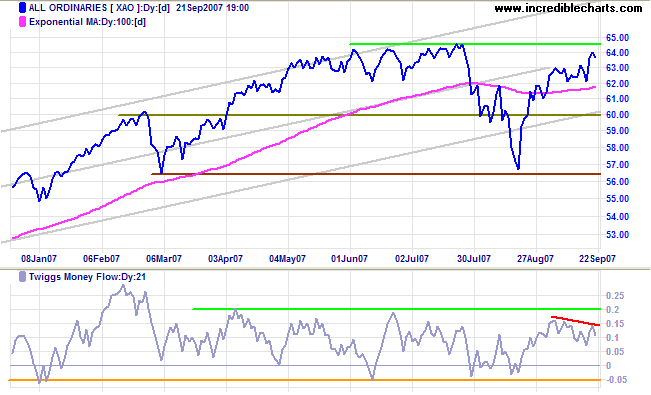
Short Term: Large volume on Thursday is attributable to option closes. The index is consolidating above 6360 after Wednesday's breakout, awaiting further direction. Reversal below 6200 would indicate another test of primary support at 5650, while breakout above 6460 would signal a test of the upper trend channel.
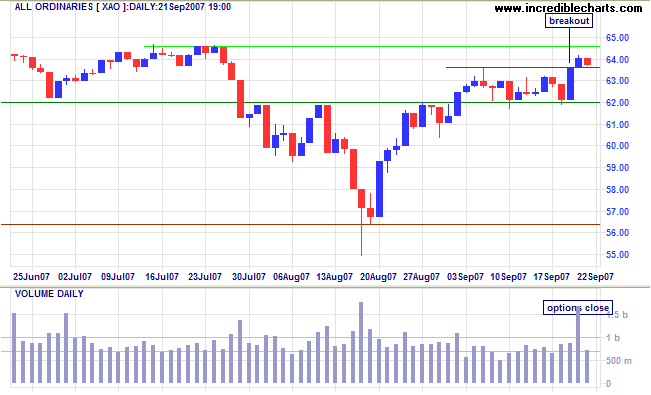
What is the basis of all these forecasts......? The acting
principle behind the tabulations is hope. Everybody desires
that prosperity should continue and increase..... We are a
childish people; we like to be told what we want to believe.
But are these forecasts really as searching as they sound?
After laboring over a number of them one curious thought
emerges and perhaps only in one case is it recognized
distinctly by the forecaster. This is that nobody takes a long
view.
~ William Peter Hamilton: The Wall Street Journal, January
1929.
To understand my approach, please read Technical Analysis & Predictions in About The Trading Diary.

Author: Colin Twiggs is a former investment banker with almost 40 years of experience in financial markets. He co-founded Incredible Charts and writes the popular Trading Diary and Patient Investor newsletters.
Using a top-down approach, Colin identifies key macro trends in the global economy before evaluating selected opportunities using a combination of fundamental and technical analysis.
Focusing on interest rates and financial market liquidity as primary drivers of the economic cycle, he warned of the 2008/2009 and 2020 bear markets well ahead of actual events.
He founded PVT Capital (AFSL No. 546090) in May 2023, which offers investment strategy and advice to wholesale clients.
